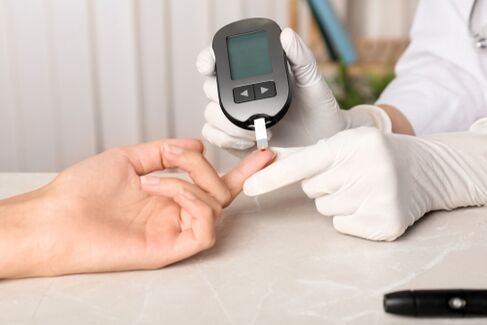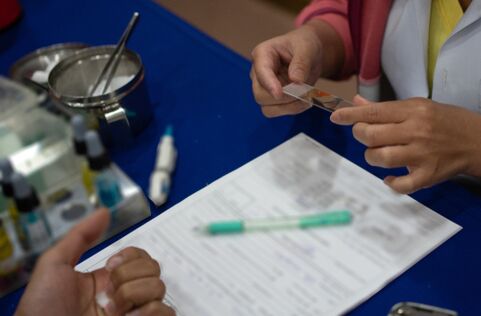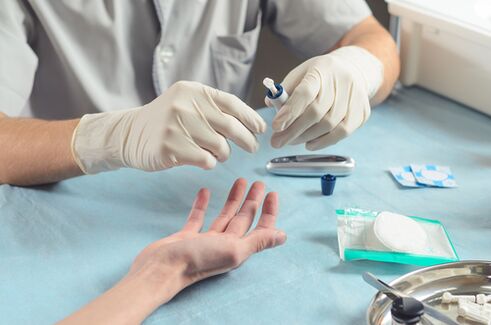
Diabetes mellitus is a chronic endocrine disease that is characterized by foods from foods that are needed for nutrition, breathing, and energy metabolism. In this case, production or interaction with the pancreas hormone - insulin deteriorates. There is a need to regulate the quantitative presence of glucose in the bloodstream. With the inadequate function of a pair of glucose -sensulin, hyperglycemia is a lasting increase in glucose. Metabolism suffers, the work of the kidneys, the heart, the blood vessels and the central nervous systems is disturbed.
Types of diabetes
Two main types of diabetes are distinguished, which, although belonging to a group of endocrine diseases, still have differences.
The first type of diabetes (insulin -dependent, juvenile, inzsd type type)
This is characterized by the fact that the immune system attacks the beta cells (more than 80%) of the pancreas for any reason, produced by insulin. There is no hormone, but glucose is constantly transported to the body by food. Blood sugar levels go out on the scale. The first type of diabetes is most often detected in childhood or adolescence. But this is not uncommon for adults.
Type second type of diabetes (insulin -dependent, II II)
The II. Type of diabetes is more often diagnosed with people after 30-40 years. But the disease is getting younger. In 90 % of cases, patients have excessive weight. The body can continue to produce insulin, but cell sensitivity to insulin decreases (this is called insulin resistance). The vicious circle arises. The cells do not feel insulin, the body produces even more insulin for food; cage. Glucose simply accumulates in the blood and insulin increases appetite. Man eats, jumps into sugar, and insulin resistance increases.
Prediabet
Here, glucose levels exceed the reference values, but it cannot talk about diabetes. Prediabet in II. Type diabetes and cardiovascular disease.
Pregnancy diabetes is typical during pregnancy. Most often it is located in trimester II or III.
In addition, the course of the disease differs in severity: light (i), medium (II) and heavy (III).
Diabetes. Symptoms
If you do not have the habit of giving blood to glucose once a year and does not know the clinic's endocrinologist in person, there are many symptoms that can tell you that it is time to contact a specialist. But we book immediately, and signs of diabetes occur when insulin deficiency is already a critical point. Therefore, the most effective way to discover the sugar level is to donate blood.
The first type of diabetes
Symptoms of first type of diabetes:
- constant, insatiable thirst;
- dry mouth;
- frequent urination;
- apathy and fatigue;
- insatiable hunger;
- weight loss (average 3-5 kg), which is not related to a person;
- Problems of vision (the blurry of the image, as if it were in every fog).
The second type of diabetes
Symptoms of second type of diabetes are similar to type I diabetes in certain parameters: thirst, hunger, dry mouth, fatigue, visual problems and toilet desires. But this type has its own signs:
- numbness and tingling in the arms and legs;
- Slow wound healing and recurring infections.
Causes of diabetes

Unfortunately, scientists cannot name the exact causes of the development of diabetes in humans (especially the first type). Poor ecology, virus infections, and the inadequate operation of the immune system serves as a basis. The causes of diabetes mellitus are generally distinguished:
- Hereditary predisposition. In addition, the risk reaches 10%when the father is in the first type of diabetes and 2, 5%if the mother. If both parents II. There is diagnosis of type of diabetes, the child's risk of this disease increases to 65-70%after 40 years;
- The unbalanced diet with a lot of carbohydrates;
- Overweight (90% of people with type II inzd);
- lack of physical activity;
- stress constantly;
- prediabet;
- Longer use of certain drugs (diuretics, hormonal, salicylates, cytostatics, etc. );
- ethnicity (the risk of developing type 1 diabetes in children of the European species);
- History of pregnancy diabetes;
- The chronic insufficiency of adrenal glands.
Complication
This disease is misleading, and if you do not observe your doctor's instructions, you can have complications of diabetes (chronic and acute) that endanger the work of the entire body. Chronic complications can be observed when the high levels of sugar last long.
The following chronic complications can be distinguished:
- The fragility of the retinopathy (retinopathy) leads to a decrease in visual acuity, early development of cataracts or blindness.
- In diabetes, periodontitis often occurs, leading to loss of teeth or heart problems. In addition, various infectious diseases of the oral cavity are possible. You should pay attention to hygiene and visit the dentist regularly.
- Cardiovascular diseases in diabetics are the most common causes of disability and death. Angina pectoris, myocardial infarction, stroke and others. Lack of observation of cholesterol and glucose levels and increased blood pressure contribute to the development of these complications.
- The destruction of nephropathy or blood vessels in the kidneys leads to the failure of the operation or denial of the kidneys. Hell control is required.
- Neuropathy (nerve damage). Most often, the risk of neuropathy is exposed to the legs. The walls of the blood vessels and the nerve fibers are destroyed and the blood flow to the legs deteriorates. Signs of the development of neuropathy are tingling, pain, climbing goose pumps or loss of sensitivity. Patients, especially the elderly, usually do not conclude the meaning of ulcers, infectious diseases and amputation. Neuropathy can affect other body systems (erectile dysfunction, gastric intestinal tract problems, genitourinarinal system).
- Diabetes is one of the causes of atherosclerosis because the blood vessels are fragile, fragile and increases the risk of thrombus.
- There are often joint pain as diabetes leads to a reduction in the amount of synovial fluid.
- In addition, there is a high frequency of mental disorders.
Acute complications that develop rapidly are usually combined with fluctuations in blood sugar levels. It leads to low (hypoglycaemia) and high (hyperglycemia) crises. The crisis of hypoglycemia (3, 9 mmol/l) is manifested as a seizure, and hyperglycemic crises are dangerous to the occurrence of diabetic ketoacidosis and hyperosmolar hyperglycemic. These are emergency and threatening conditions that lead to cramps, coma and deadly results.
Diagnosis of diabetes
Diagnosis of diabetes is an important step. In the ideal situation, one should be aware of glucose levels, especially after 45 years. But if you endanger, the analysis should be done more often and you should do this earlier not to miss the valuable time.
Diabetes is diagnosed with several ways:
- Analysis of glycated hemoglobin. The results of the analysis in the blood show the average level of glucose over the past 2-3 months. So you can track the dynamics;
- Analysis of blood plasma glucose (capillary or venous) on an empty stomach. The inspection currently presents the situation of glucose;
- The glucotolerant test is prescribed in doubt. The test lasts for a long time and includes the measurement of glucose levels before taking a glass of water with dissolved glucose;
- Analysis of urine for the presence of glucose and/or acetone. A healthy person is not characterized by the presence of these elements in the urine.
Treatment

The main treatment of insulin in the treatment of type I diabetes mellitus is the main treatment of insulin, which should be administered every day at a dose prescribed and calculated by the participating physician. You can use special insulin syringes, syringes or gaps or insulin pumps, calculating the required dose of the hormone submitted. Under certain circumstances, medicines can be prescribed for diabetes that stimulate the body to develop their own insulin.
In the first species diabetes, chips insulin every day as passes lead to diabetic ketoacidosis, which leads to death. Daily insulin + proper nutrition + physical activity can live life without complications.
The II. In the case of type of diabetes, the doctor prescribes medication aimed at reducing the sugar level and normalizing the condition of the person. Occasionally, substitution treatment with insulin may be needed, but this does not have to be received daily. The diet of diabetes without malfunction, as well as the increase in physical activity and body weight regulation.
In the presence of diabetes, the examination should be performed once every six months or once a year. You also need to get rid of excessive weight and switch to dietary nutrition.
In pregnancy diabetes, you should carefully monitor glucose levels in the blood and follow the attentive doctor's recommendations. Most often after childbirth, blood glucose levels are normal. But there is a risk of developing second type of diabetes.
Forecast and prevention
Diabetes mellitus is a severe endocrine disease that reduces life 5-10 years and men die more often than women. Infectious and viral diseases are tolerated more severely. In the background of pneumonia, the influenza complications are 6 times more common, compared to statistics from people without diabetes. In healthy people, compared to diabetics, other forms of Alzheimer and dementia are rare. 
But you can fight and have to fight for diabetes. Competent management helps them avoid many problems and complications. Thus, 50-60% of the cases of the disease stabilize and do not advance.
Proper control and prevention of diabetes:
- Regular glucose control;
- Special diet for diabetes;
- Sports game in moderate mode;
- observation of blood pressure and cholesterol;
- Regular visit to necessary professionals and surveys;
- Taking medications prescribed by a doctor.
Diabetes are not completely examined, but the conscious attitude of medicines and their lives can help live with this disease for a long time and without complications.
























